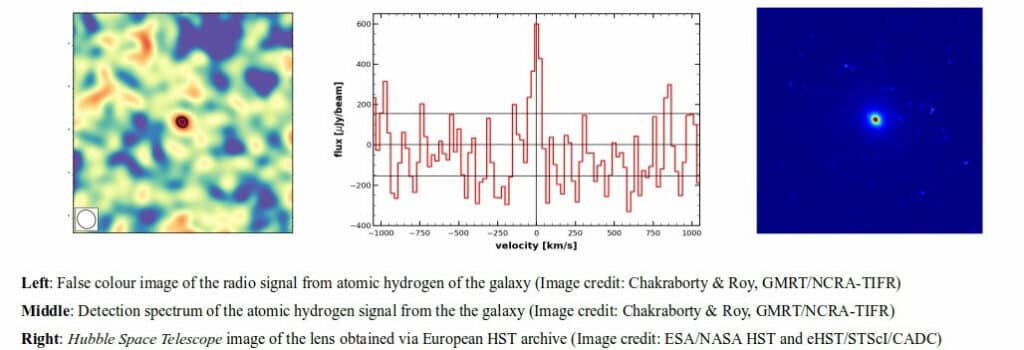Detecting radio signals emitted by nearby galaxies could help astronomers answer how stars form in distant galaxies. Until now, it’s only been possible to capture this particular signal from a galaxy nearby, limiting our knowledge to those galaxies closer to Earth. However, these signals become weaker the further away a galaxy is from Earth, making it difficult for current radio telescopes to pick up.
Thanks to gravitational lensing, astronomers from Montreal and India have captured a radio signal from the most distant galaxy. Astronomers captured a faint signal from a record-breaking distance- so far at a specific wavelength known as the 21 cm line.
For this discovery, astronomers used the Giant Metrewave Radio Telescope in India. This is the first time this radio signal has been detected at such a large distance, allowing astronomers to explore the secrets of the early universe.
The signal was found to come from a distant star-forming galaxy known as SDSSJ0826+5630, which exists 8.8 billion light-years away. This distance indicates that the galaxy is closer to the Big Bang.
Interestingly, scientists were also able to measure its gas composition. They observed that the atomic mass of the gas content of this particular galaxy is almost twice the mass of the stars visible to us.

Arnab Chakraborty, a Post-Doctoral Researcher at McGill University under the supervision of Professor Matt Dobbs, said, “The signal detected was emitted from this galaxy when the universe was only 4.9 billion years old, enabling the researchers to glimpse into the secrets of the early universe. It’s the equivalent to a look-back in time of 8.8 billion years.”
Co-author Nirupam Roy, an Associate Professor in the Department of Physics at the Indian Institute of Science, said, “Gravitational lensing magnifies the signal coming from a distant object to help us peer into the early universe. In this specific case, the signal is bent by the presence of another massive body, another galaxy, between the target and the observer. This effectively results in the magnification of the signal by a factor of 30, allowing the telescope to pick it up.”
According to the researchers, these findings show that gravitational lensing can be used to observe distant galaxies under comparable circumstances. It also creates fascinating new possibilities for using current low-frequency radio telescopes to study the cosmic evolution of stars and galaxies.
Journal Reference:
- Arnab Chakraborty, Nirupam Roy. Detection of H I 21 cm emission from a strongly lensed galaxy at z ∼ 1.3. Monthly Notices of the Royal Astronomical Society, 519 3, March 2023. DOI: 10.1093/mnras/stac3696
https://news.google.com/__i/rss/rd/articles/CBMiVWh0dHBzOi8vd3d3LnRlY2hleHBsb3Jpc3QuY29tL2FzdHJvbm9tZXJzLWNhcHR1cmVkLXJhZGlvLXNpZ25hbC1kaXN0YW50LWdhbGF4eS81NjMyOS_SAVtodHRwczovL3d3dy50ZWNoZXhwbG9yaXN0LmNvbS9hc3Ryb25vbWVycy1jYXB0dXJlZC1yYWRpby1zaWduYWwtZGlzdGFudC1nYWxheHkvNTYzMjkvP2FtcD0x?oc=5
2023-01-23 08:53:01Z
1742508293
Tidak ada komentar:
Posting Komentar